I can say nothing more than what has been written extensively by others, so for family and friends, I will provide an amalgam of information from the web, our impressions, and photos.
We are now in the Khorezm region of Uzbekistan.
Khiva came to be when someone discovered water, an essential for the caravans on the Silk Road. The name comes from Khey-vakh, which means sweet water. Ichan Qa'la was the last oasis on the Silk Road for people coming from the west to stock up on their supplies.
This post would be remiss if it neglected to mention that from the 16th to the late 19th century, Khiva was a major slave trading center in Central Asia. Here's what an internet search produces:
At the height of this practice, tens of thousands of people were held in the Khanate of Khiva, awaiting their sale. The slave trade extended into other areas of the country. Bukhara held special bazaars where slaves were bought and sold, and at times had markets even larger than in Khiva. Samarkand and Tashkent served as transit points for the trade.
Slave labour was used in agriculture (especially cotton), domestic and military service and construction. Their use served to make the wealthy richer.
As Russia expanded their rule over these areas (starting in 1873), it abolished the slave trade.
While slavery has not occurred in this region for a century and a half, there are lingering effects. Certain areas repeatedly raided for their people suffered population depletion and economic disparities that negatively affected their growth and development, even today. For the Central Asian peoples involved in the slave trade, there is a cultural memory of a relationship with Russia that ended their activity. Within Asian groups, there remains some tensions between ethnic groups that can be traced back to the slave trade. Finally, some of the vulnerabilities that enabled the ancient slave trade are thought to contribute to today's human trafficking routes.
Many consider this historic 32-foot-high walled place and UNESCO World Heritage Site a living museum, as people live and work here. Others call it a tourist trap when they see the many stalls that sell Uzbek wares. However, as I alluded to in a recent post, the Uzbekistan government is supporting artists and craftspeople to learn and practise ancient arts and crafts, and one part of this effort has been to designate certain areas in the country to do that. Itchan Qa'la is one such designated place. I admire that initiative.
Many of the buildings here, while made of mud and straw, are remarkably well-preserved. I can't speak to the architecture, but it's said to represent the cultural exchanges that happened over centuries because of the Silk Road.
Today, these inner walls house about fifty historical monuments, two hundred and fifty households, hotels, guesthouses, Bed & Breakfasts, restaurants, educational centers (madrasas), palaces and minarets.
While a bit out of the way, our hotel provides a free and on-demand driving service (a golf cart or minibus) into town, both of which are very efficient. It also has a lovely pool, good breakfast, and housekeeping services.
Breakfast is served daily in what is affectionately called the Wedding Room.
The two-day pass to the inner city costs UZS 200,000 (about CAD 21), a very reasonable fee. A few things inside require extra admission, but on our second day, there is a National holiday, and those fees are waived.The outer walls are impressive with their mass (5-6 meters thick, 8-10 meters high and 6,250 meters long) and four gates facing the cardinal directions.
The walls lit at night:
The triangle-shaped bumps in the wall are burial sites. We see no names or dates on them, nor have we found online information about who may be buried there.
These graves are quite different from the ones found inside the walls.
The photo below highlights the importance of Khiva to the Silk Road travellers.
West Gate (by day and by night) is our daily entrance to the inner sanctum since it is the most convenient for the hotel transportation.
We find our way around with this map on the wall, as the one given with the tickets is hard to read, and we always know where this one is.
Inside West Gate is mostly where all the artisans and sellers of Uzbekistan silk, weaving, woodwork and ceramics are located.
The first sights to hit the visual sense are the intricate ceramic tile work on buildings, and the vista of domes and minarets.
Most impressive is the Kalta Minaret, started in 1852 by the Khiva ruler Muhammad Amin Khan. Due to his untimely death a few years later, it remains unfinished at only one-third of its intended height. Impressive now, it stands 29 meters high and is 15 meters in diameter. Here it is by day and at night.
Other examples of tile work:
And the above madrasah in the evening
Note the calligraphy incorporated on the tile work below
The lobbies of some hotels have impressive plasterwork such as the one below.
Just a few of the domes that dot the landscape:
A bride and groom make their way past us to pose for some wedding photos: A little while later, four men walk along with an apparent leader calling out in a sing-song voice. Perhaps he is leading the others in prayer? The ancient Juma Mosque (a World Heritage Site) sits in the middle of Ichan Qa'la where east and west points connect. It's thought to date to the 10th and 11th centuries. The 213 ornately carved wood poles are highlighted by several pyramidal skylights.

Below is a section of pole in close up to see the carved detail
Madrassas were centers not only of religious education, but of mathematics, astronomy, and geography. In the early twentieth century, this area and its more than 65 madrassas attracted students from all over Europe.
The Tash-Hauli Palace (AKA: the Kunya Ark) built in the 1830s, was the living quarters of Khiva ruler Allah Kuli Khan.
Carved and painted ceiling in the courtyard above:
Ceiling in the room above:
The old town has many small museums in its ancient buildings. Sometimes we are the only people going through them. One of our favourite little museums was one on folk medicine...
A scholar from Uzbekistan wrote a textbook that was the standard in medical schools throughout Europe and the Middle East for over 700 years. Scholars from here also made extensive contributions to pharmacology by documenting their deep knowledge of the medicinal use of herbs and other plants. And some of the earliest hospital networks were established here.

...and another was on calligraphy, printing and lithography
Scholars from this area developed writing systems and scripts, block printing and the standard production of books and library systems. They further developed paper-making systems that originated in China and spread this knowledge westward.
Below are the early print makers hard at work.
...and another on the mint (money-making) of the day:
It's so refreshing in a historical site to see only a few statues, and the few that we do see are delightful, as there is joy in each.
There are many places to eat here, either inside or outside. This is our favourite place for lunch with the atmosphere and friendly staff.
For a quick snack, the somsas this woman makes in the wood-fired tandoor is delicious, crunchy on the outside, with wonderful meat or vegetable stuffing inside.
On the other hand, this is our favourite place for dinner. We arrive while it's still light, but before the sun sets, we see the sunset colours over the sand-coloured buildings. Finally, the lights come on, and it's a different view again. The third story gives a panoramic view over Itchan Qa'la.
This talented young woodworker speaks good English and allows us to photograph him at work. He makes a very ingenious stand from one piece of wood that will morph into five different positions. Depending on the intended use (cookbook, phone stand, etc.) there are various sizes.
We start the second day with a walk through the residential area, a peaceful reprieve from the crowds in the other areas of town. The homes are well-kept, and often opposing doors are wide open to let any cooling breeze flow through the house. As always, we are interested in doors as both form and function.
This second day is a national holiday, and scores of school children are everywhere. We are swarmed by them most of the day to a point where we find ourselves doing evasive manoeuvres to avoid them. Their English is limited to "What's your name?, My name is, Where are you from?, and Photo?" We have more selfies with children than we care to think about.
We are sad about this poor Bactrian (AKA Mongolian or two-humped) camel. It is on a short chain in the hot sun, with no water around. Someone has him to charge money when you get your photo taken with him. We took this photo on the sly. These camels are common in the Kyzyl Kum desert of Uzbekistan and were very important on the Silk Road and as pack animals by the armies of Gengis Khan. They can withstand extremes of heat and cold, having adapted to the climate of Central Asia, however, they are virtually extinct in other parts of the world.
Beside our hotel is a huge building and grounds by the same name, supposedly a former palace. We see four deformed-looking sheep tethered in the orchard. In fact, they are known colloquially as fat-tailed sheep. They have been domesticated for thousands of years in a few parts of the world. In Central Asia, they are known as Karakul sheep. The fat serves a similar purpose to the animal as a camels hump(s) does to the camel (namely to store fat for energy in times of food scarcity and to help with thermoregulation in extreme desert heat and cold). These sheep are prized for their meat and wool, and their fat was used in cooking and traditional medicine. The fat is not like regular body fat and is valued for its flavour and cooking properties.
A traditional hat called the Karakul Hat (AKA: Chugurona) is made from the wool of these sheep. We assume that they are to be worn in winter, and they are, but more importantly, they are worn in the very hot summers to insulate the head from the heat. They come in white, for the tourists, a multitude of fake colours and straight or shaggy.
A group of youthful tourists in traditional robes and the Karakul Hat are having fun, and two pose for Paul.
We leave Khiva with a good impression and look forward to Bukhara, the next destination, followed by the well-regarded Samarkand, before flying off to Bucharest. 'Till next time:
Ha ha. On departure we discover the broad boulevard that leads straight to Ichan Qa'an. Fancy hotels line it.
MISCELLANEOUS PHOTOS
Two ceilings
The photos below are in a museum that tells the history of Khiva within the context of Uzbekistan and Central Asia.





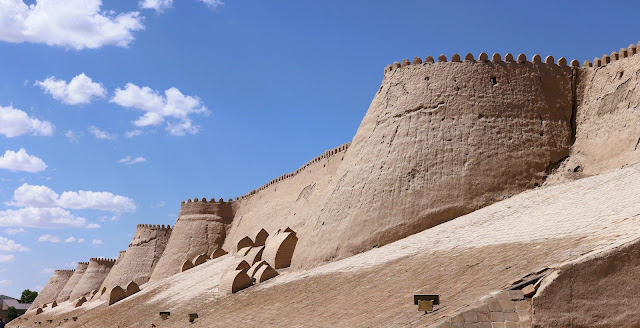

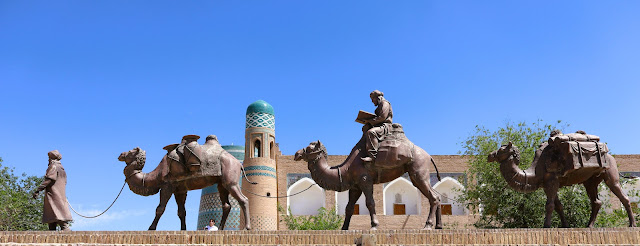












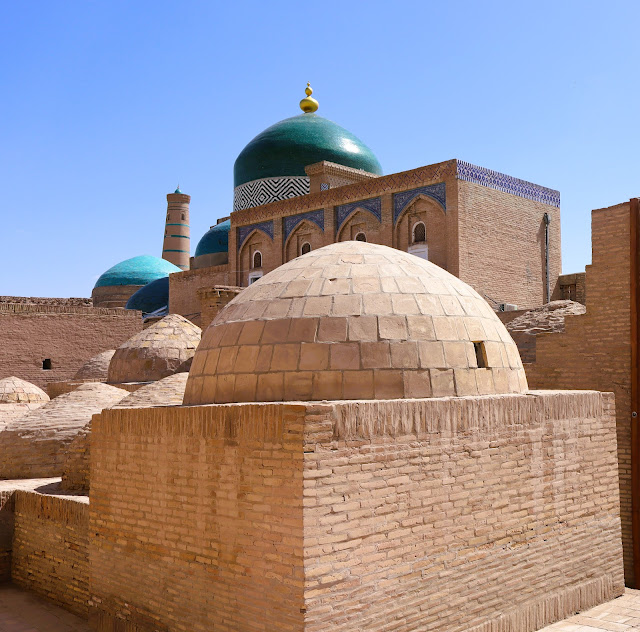















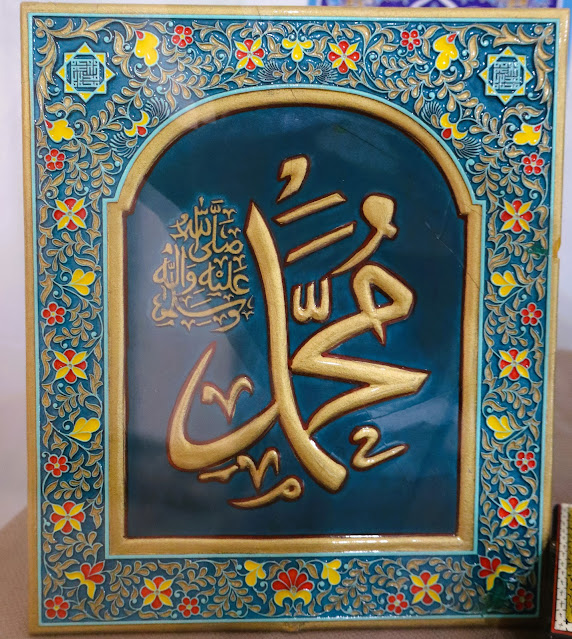












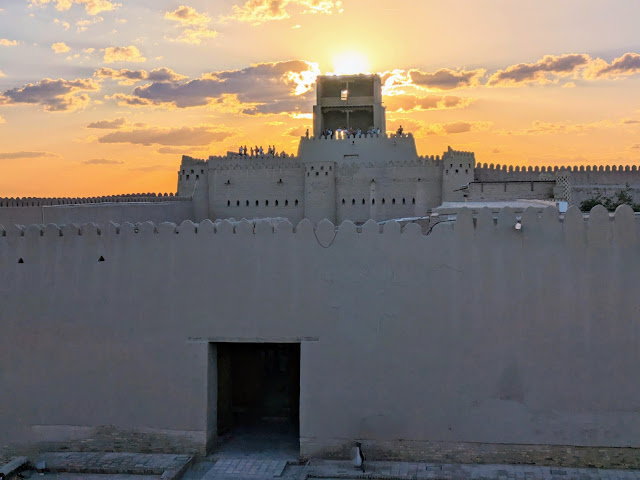





















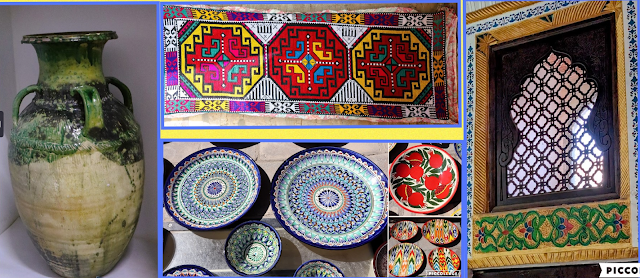





No comments:
Post a Comment